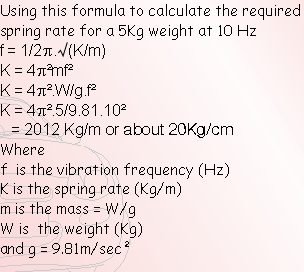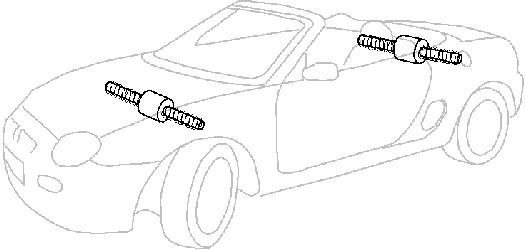If the damper is made in the form shown, with the weight sliding on a bar and restrained by a pair of springs, each spring would need to be half as stiff as a single spring. So in round figures, it would need a 5Kg weight with a pair of 10Kg/cm springs. The weight could be 8cm diameter, about 13cm long on a 2cm diameter bar. The assembly could then be housed within a cylinder about 10cm diameter, 50cm long.
It should be possible to mount two of these assemblies from reasonably strong parts of the bodywork as shown here. I've sketched them rather larger than the dimensions I've used above to make them stand out.



All open-top cars experience scuttle shake to some extent. Although the MGF probably lies towards the better end of the spectrum, there is scope for improvement. The TF addresses this with additional bracing behind the dashboard and in the engine bay, and with one-piece sills. These no doubt are helpful even if they won't eliminate the symptoms.
It is basically caused by the body structure acting as a torsional spring with the masses of the front subframe/suspension and the powerplant at the rear giving rise to a natural frequency of about 10 Herz. This damps out quite quickly, but must generate varying load oscillations on the tyres. If this happens during energetic cornering, one can reasonably expect a portion of the available grip on the road to be lost.
One means of reducing the effects of such vibration is through the use of harmonic or mass dampers. These can be tuned to a specific frequency, and can be very effective at reducing the amplitude of the vibration. I believe that recent Audi A4 convertibles are fitted with a harmonic damper, so its effect must be worth the increased cost.
Such a damper is basically created by attaching a suitable mass to a spring which is in turn attached to the vibrating body (see the sketch below). This spring/mass system is tuned to the resonant frequency of the vibrating body. The result is that the vibration energy passes into the harmonic damper which oscillates 180 degrees out of phase, thus applying an opposite force which reduces the amplitude of the basic vibration.
In the case of the MGF, there seems to be enough space to fit a pair of dampers, under the front bonnet and against the engine compartment rear bulkhead. A rough calculation using the standard vibration frequency formula suggests that a useful mass could be used, and the locations would be well suited for it to be effective.


Unfortunately, having had these thoughts, I'm unable to do any more than think, as I don't have the facilities to attempt a prototype. If anyone reading this reckons they could do what I can't, I would be highly delighted to have a chat! You can email me here.
Welcome - Home - Mass Dampers